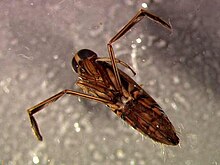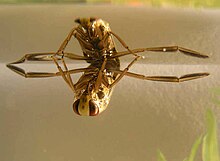| Revision as of 17:03, 27 August 2016 editWidefox (talk | contribs)Autopatrolled, Extended confirmed users, Page movers, IP block exemptions, New page reviewers, Pending changes reviewers, Rollbackers106,905 edits fix XML parse, link← Previous edit | Revision as of 07:25, 12 December 2016 edit undoTransphasic (talk | contribs)Extended confirmed users5,709 editsmNo edit summaryNext edit → | ||
| Line 27: | Line 27: | ||
| Notonectidae are similar in appearance to ] (common names 'Water boatman' in the US, 'Lesser water boatman' in the UK), but can be distinguished by their larger size (up to 20 mm), dorsal-ventral coloration, front legs, and ]. Their dorsum is convex, lightly colored without cross striations. Their front tarsi are not scoop-shaped and their hind legs are fringed for swimming. There are two subfamilies, ] and ], each containing four genera. | Notonectidae are similar in appearance to ] (common names 'Water boatman' in the US, 'Lesser water boatman' in the UK), but can be distinguished by their larger size (up to 20 mm), dorsal-ventral coloration, front legs, and ]. Their dorsum is convex, lightly colored without cross striations. Their front tarsi are not scoop-shaped and their hind legs are fringed for swimming. There are two subfamilies, ] and ], each containing four genera. | ||
| The most common genus of Backswimmers is '']'' – streamlined, deep-bodied bugs up to 16 mm long, green, brown or yellowish in colour. ''N. maculata'', is distinguished by its mottled brick-coloured forewings. | The most common genus of Backswimmers is '']'' – streamlined, deep-bodied bugs up to 16 mm long, green, brown, or yellowish in colour. ''N. maculata'', is distinguished by its mottled brick-coloured forewings. | ||
| Backswimmers swim on their backs, vigorously paddling with their long, hair-fringed hind legs and attack prey as large as ]s and small fish. They can inflict a painful "bite" on a human being (actually, similar to a mosquito "bite", it is a stab with their tubular mouthpart). They inhabit still ], e.g. lakes, ponds, marshes, and are sometimes found in garden ponds. Although primarily aquatic, they can fly well and so can disperse easily to new habitats. | Backswimmers swim on their backs, vigorously paddling with their long, hair-fringed hind legs and attack prey as large as ]s and small fish. They can inflict a painful "bite" on a human being (actually, similar to a mosquito "bite", it is a stab with their tubular mouthpart). They inhabit still ], e.g. lakes, ponds, marshes, and are sometimes found in garden ponds. Although primarily aquatic, they can fly well and so can disperse easily to new habitats. | ||
Revision as of 07:25, 12 December 2016
| Notonectidae | |
|---|---|

| |
| Scientific classification | |
| Kingdom: | Animalia |
| Phylum: | Arthropoda |
| Class: | Insecta |
| Order: | Hemiptera |
| Suborder: | Heteroptera |
| Infraorder: | Nepomorpha |
| Family: | Notonectidae |
| Subfamilies, Genera | |
|
8 genera in 2 subfamilies; see text | |
Notonectidae is a cosmopolitan family of aquatic insects in the order Hemiptera, commonly called Backswimmers because they swim upside down. The Common Backswimmer, Notonecta glauca, is widespread in the United Kingdom, where it is known as the greater water boatman, and in Europe.
Notonectidae are similar in appearance to Corixidae (common names 'Water boatman' in the US, 'Lesser water boatman' in the UK), but can be distinguished by their larger size (up to 20 mm), dorsal-ventral coloration, front legs, and predatory behavior. Their dorsum is convex, lightly colored without cross striations. Their front tarsi are not scoop-shaped and their hind legs are fringed for swimming. There are two subfamilies, Notonectinae and Anisopinae, each containing four genera.
The most common genus of Backswimmers is Notonecta – streamlined, deep-bodied bugs up to 16 mm long, green, brown, or yellowish in colour. N. maculata, is distinguished by its mottled brick-coloured forewings.
Backswimmers swim on their backs, vigorously paddling with their long, hair-fringed hind legs and attack prey as large as tadpoles and small fish. They can inflict a painful "bite" on a human being (actually, similar to a mosquito "bite", it is a stab with their tubular mouthpart). They inhabit still freshwater, e.g. lakes, ponds, marshes, and are sometimes found in garden ponds. Although primarily aquatic, they can fly well and so can disperse easily to new habitats. They seem to be attracted to light; similar to a moth drawn to a flame. For instance, if a Backswimmer enters a swimming pool with an LED light seen under the water, it will inspect the light by swimming up close to it and never leaving that spot.




In contrast to other aquatic insects that cling to submerged objects, Anisops deanei uses a unique system to stay submerged: using the extra oxygen supply from haemoglobin in their abdomen, instead of using oxygen dissolved in the water. The size of these air bubbles, which provide buoyancy, changes as the nitrogen dissolves into the blood and the oxygen is used in respiration. This allows for regulation of the size of the air bubbles and their concentration of oxygen.
Notes
- BBC Science and nature factfiles: Water boatman, common backswimmer Retrieved on 2008-07-26
- physorg.com: Gold Strike in Science World Retrieved on 2008-07-26
- Diving insects use buoyancy vests New Scientist 2006-04-11 p.19 Retrieved on 2008-07-26
References
- Chinery, M. (1986). Collins Guide to the Insects of Britain & Western Europe. Collins. ISBN 0-00-219137-7.
- Fitter, R. & Manuel, R. (1986). Collins Field Guide to Freshwater Life. Collins. ISBN 0-00-219143-1.
- Hungerford, H. B. (1933). The genus Notonecta of the world. U. Kansas Sci. Bull. 21: 5-195.6+516+2kkig
- Painful bug bite, Williams 1980, Hawking & Smith 1997
- Notonectidae, Australian Freshwater Invertebrates
External links
- Notonectidae, BugGuide
- Close-up photo by J. Hlasek
- Photo of Anisops assimilis swimming by Paddy Ryan
- BBC Radio special on the sounds made by water boatmen